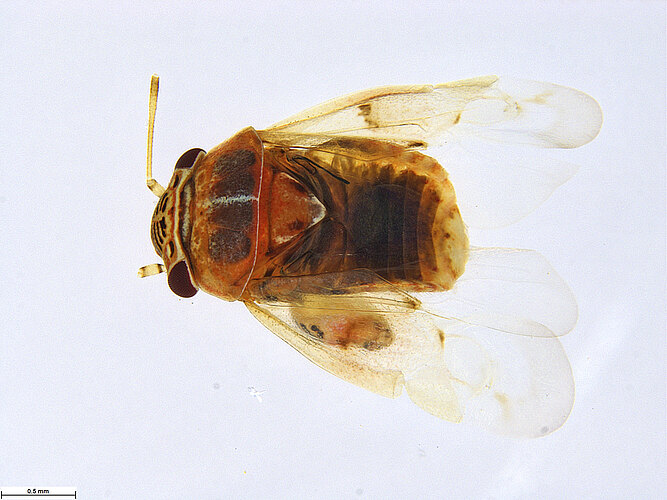Pilbara Bug Coridromius pilbarensis Tatarnic & Cassis, 2008
Fauna Portal species: 953Diagnosis
(after Tatarnic & Cassis 2008): Coridromius pilbarensis is recognized by the following combination of characters: unique orange, brown, and yellow coloration; proepisternum unilobed; metanotum not prominently flared; posterior margin of pygophore biconvex, with prominent fold on left side forming U-shaped groove, with small apophysis on right margin of groove. Of the Australian species chenopoderis, monotocopsis and pilbarensis, the latter is the largest and generally most consistent in its coloration. Males are readily told by the small ventral apical process adjacent to the deep folded groove on the posterior margin of the pygophore, while females typically have a faintly greenish abdomen.
Status
- native
Linnean Holotype
Australia
- Australian Capital Territory
- New South Wales
- Western Australia
Fauna Portal Records
The map shows all records that have been verified as part of the Fauna Portal project and may not represent the true distribution of a species. Specifically, for described species, check the link to the Atlas of Living Australia on this page for potential wider distributions. Fauna Portal Reference specimens and Linnean types are shown in red. If you identified a specimen that exceeds the distribution of an undescribed species as illustrated here, please contact the Fauna Portal team who can assist with the lodgement of the specimen in a public institution and display on the map.
Publications
Tatarnic NJ, Cassis G (2008): Revision of the plant bug genus Coridromius Signoret (Insecta: Heteroptera: Miridae). Bulletin of the American Museum of Natural History. 315: WEB
Hemiptera - Heteroptera (True Bugs)
All classes
- Arachnida
- Crustacea
- Insecta
- Blattodea s. str. (Cockroaches)
- Coleoptera (Beetles)
- Dermaptera (earwigs)
- Diptera (flies, mosquitos)
- Hemiptera - Auchenorrhyncha (cicadas, planthoppers)
- Hemiptera - Heteroptera (True Bugs)
- Hemiptera - Sternorrhyncha (aphids, scales etc.)
- Hymenoptera - Formicidae (Ants)
- Hymenoptera excl. Formicidae (bees and wasps)
- Orthoptera - Caelifera (Grasshoppers)
- Trichoptera (Caddisflies)
- Myriapoda

